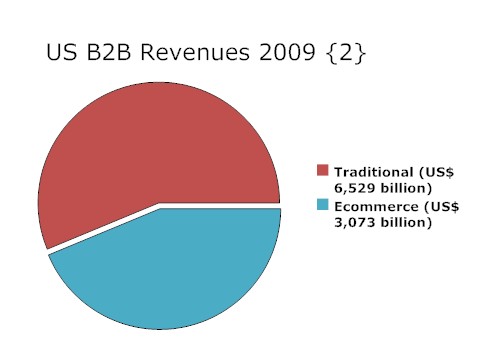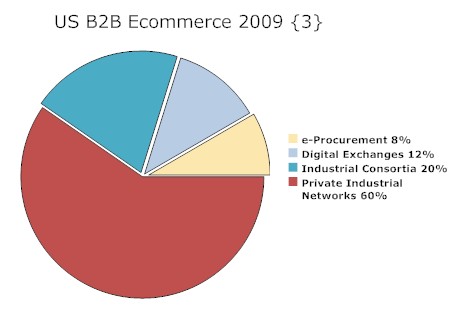 Section
Navigation
Section
Navigation
2. Social Dimension
2.1.
Scope of the Internet
2.2
Business to Business Successes
2.3
Business to Customer Successes
2.4
History of the Internet
2.5
Differences: India and China
2.6 eBusiness
Law
2.7 eBusiness Tax
2.8
Cyber Crime
2.9 Cyber Wars
2.10
The Death of Print
2.11 Intellectual
Property Issues
2.12 Online Privacy
2.13 Governance of the Internet
2.14 Welfare Issues
2.15
Internet Prospects
 2.2.
B2B Success Stories
2.2.
B2B Success Stories
Even from early dotcom days, business to business transactions were destined to be important. 'According to studies published in early 2000, the money volume of B2B exceeds that of e-tailing by 10 to 1. Over the next five years, B2B is expected to have a compound annual growth of 41%. The Gartner Group estimates B2B revenue worldwide to be $7.29 trillion dollars by 2004.' {1} The same article saw B2B ventures as company web sites, product supply and procurement exchanges, specialized or vertical industry portals, brokering sites and information sites. Today, that list has expanded, and can be grouped in two categories:
1. Business to Business
B2B companies sell to other companies, notably:
1. E-Distributors
that sell goods and services direct to companies.
2. E-Procurement
companies that create and sell access to digital markets.
3. Digital
exchanges (electronic marketplaces) where hundreds of suppliers meet large
commercial purchasers.
4. Industrial Consortia
( industry-owned vertical marketplaces) that serve specific industries.
5.
Private Industrial Networks (Private
Trading Exchanges or digital networks) that coordinate the flow of information
between companies that do business together.
2. eCommerce Enablers
Companies that enable Internet business between companies, by supplying:
1. Computers
and servers.
2. Operating systems.
3. Routers.
4. Ecommerce
systems.
5. Customer relationship
management software.
6. Encryption
software.
7. Streaming and rich media software.
8. Payment systems.
9. Performance
enhancement software.
10. Databases.
11. Site hosting.
12. Search
engine optimization.
13. Marketing
advice.
14. General ecommerce advice.
Current Situation
That
the 10 to 1 ratio is still roughly correct. The US Census Office E-Stats report
of May 26, 2011 disclosed the following:
Revenues in US$ billions |
Total | Ecommerce | ||||
Year | B2B |
B2C | Ratio of B2B to B2C |
B2B | B2C |
Ratio of B2B to B2C |
2008 |
11,630 | 10,840 |
1.07 to 1 | 3,482 |
292 | 11.9 to 1 |
2009 | 9,602 |
10,412 | 0.92 to 1 |
3,073 | 298 |
10.3 to 1 |

Also worth noting:
1. US ecommerce revenues are now appreciable: the figures
for 2009 were $3,073 billion for B2B and $ 298 billion for B2C.
2. Fortunes
of B2C and B2B ecommerce sectors are not necessarily linked: while the first increased
2% from 2008 to 2009, the second fell by 11.7%.
2. Within the B2B sector,
manufacturing made up $1,862 billion and merchant wholesale $1,211 billion in
2009 ( from $2,171 billion and $1,311 respectively in 2008).
4. Supply chain
management is important: e-shipments were 42% of all manufacturing shipments in
2009, up from 40% in 2008.
Accurate figures are notoriously difficult to obtain, but B2B appears to dominate ecommerce in Europe, {4} and is growing fast in emerging Asian markets. {5}

 Questions
Questions
1.
Why is B2B ecommerce so important?
2. Give a detailed, two-fold grouping of
B2B ecommerce constituents.
3. Analyze current the US electronic economy.
 Sources
and Further Reading
Sources
and Further Reading
1. B2B (Business2Business or Business-to-Business)
by Paula Jones. TechTarget.
July 2000.
2. Measuring the Electronic Economy. US
Census Bureau. May 2011.
3. Author's approx. estimate based on reference
2, E-Commerce 2010 by Laudon and Traver 2010, 12. and other sources.
4. The
Growth of B2B E-commerce. BtoBB2B.
Summary of a Forrester report.
5 China's B2B e-commerce Q1 revenue hits
2.9b yuan by Hao Yan. China
Daily. April 2011. (2.9 billion yuan is US$ 444 million.)